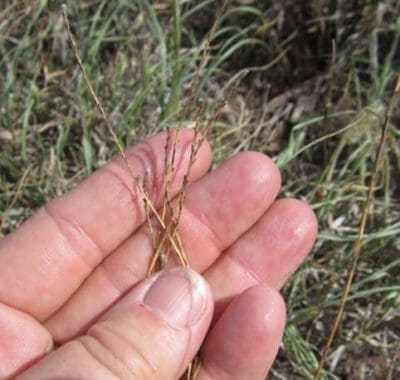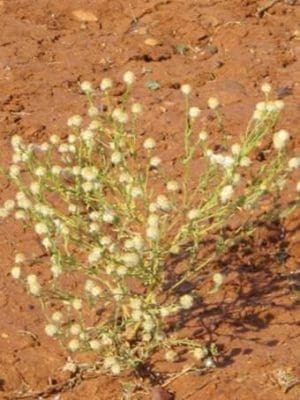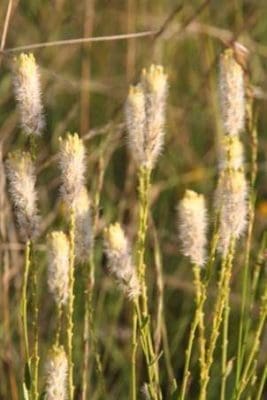Dry stalks of toxic Pimelea trichostachya in pasture.
PRODUCERS in Queensland, New South Wales and the arid zone of South Australia are being urged to keep a close eye out for the toxic native plant Pimelea.
AgForce general policy officer Marie Vitelli said Pimelea may be germinating across red sandy soils where rain events of more than 40mm rain have been recorded since March 2018.
To date, Pimelea plants near Roma, Miles and Cunnamulla have been recorded. Mrs Vitelli said there possibly there may also be Pimelea germinating in the St George/Dirranbandi region, depending on rainfall.
Mrs Vitelli said highest germination occurs in cooler months, when day/night soil temperatures fluctuate between 25oC to 15oC. High summer soil temperatures trigger Pimelea seed dormancy, and plants rarely germinate during summer rainfall events.
She said a storm cell near Stonehenge in late March 2018 triggered a germination event.
“Anyone with red, sandy soils in the western Queensland and north west NSW receiving more than 40mm rainfall since July 2018 should keep an eye out for emerging Pimelea plants,” she said.
(This PDF – Understanding pimelea poisoning of cattle – provides pictures and descriptions of Pimelea seedlings on page 18-19)
Pimelea research project update
Increased industry awareness of Pimelea’s toxic impacts to the national cattle herd across inland Australia have resulted in MLA directly funding a three-year plant toxin project continuing the rumen drench research.
A total of 43 producers, companies and organisationshave have pledged $420,000 in cash and in-kind contributions to drive forward timely research to help solve Pimelea toxicity in cattle.
First year cash co-contributions of $75,000 from producers enabled the initial MLA Donor Company project to commence in August 2017.
Mrs Vitelli said the producer cash and in-kind pledges along with MLA Donor Company project support has enabled collections of rumen fluid and Pimelea plants.
Research is progressing towards a rumen probiotic drench and effective absorbency compounds to combat Pimelea toxicity in cattle, with other activities being planned to help reduce impact and abundance of Pimelea in pasture.
Mrs Vitelli said that between between September 2017 and March 2018, the project achieved:
- 107 rumen fluid samples from Pimelea-affected cattle and unaffected cattle and other ruminants and animals grazing on Pimelea-infested pastures (sheep, goats and kangaroos). Data on animal condition, breed and rainfall data also collected from the 15 sampled properties.
- 100 kg of Pimelea plant material collected and stored for rumen research.
- Methodology to test effectiveness of absorbency compounds finalised. Initial screening showed both bentonite and biochar bind the toxin, simplexin. . Further refinement of the method will test actual dose rates of these absorbency compounds.
- Communication network for Pimelea across inland Australia from western Qld, western NSW and arid zone of South Australia. These rumen and plant collections were essential while Pimelea was seasonally abundant and are the base research material for the three-year $1.5million plant toxin project, now funded directly through MLA R&D program.
Between April and July 2018, she said research leaders Mary Fletcher (University of Qld) and Diane Ouwerkerk (DAF) had achieved:
- Genome (DNA) extraction from 107 samples obtained from animals (cattle, sheep, goats and kangaroos) and sequencing of the bacteria populations (microbiome) has been done. Currently analysing the microbiome sequence data, initially concentrating on the cattle samples. Will be looking for different groupings within the bacteria composition between unaffected and affected animals to identify target groups for isolation experiments.
- Completed two artificial rumen fermentations feeding Pimelea and Buffel grass hay, the first (11 days) was primarily for method development. The second ran for 20 days and used a pool of collected rumen samples from three unaffected cattle. Currently samples collected from the second fermentation are being analysed for simplexin breakdown. The work has shown that rumen bacteria breakdown most of the Pimelea plant material, utilise energy from the plant and release the simplexin toxin into the rumen. Further rumen fermentations over longer periods will observe the interaction of bacteria populations with simplexin over time.
- The toxin simplexin has been isolated from Pimelea plant material for use in bentonite and biochar absorbency studies to investigate both binding and release of the toxin by these absorbents.
- Sourced bentonite clay and biochar which are the absorbent compounds within several commercial blocks and developed protocols for determining their ability to bind and retain the simplexin toxin.
- Initial testing and fabrication of biopolymer formulations to release small amounts of Pimelea plant material or simplexin toxin. These biopolymers would help sustain useful rumen bacteria populations, when the toxin was absent from the diet.
- Two PhD students have commenced and are supervised by UQ researcher Mary Fletcher, together with Diane Ouwerkerk and other members of the Pimelea Project team. Overcoming Pimelea cattle poisoning will be a ‘game changer’ for cattle production, animal welfare and producer well-being across inland Australia. Hopes are high for the next three years of research.
How can producers be involved now?
Mrs Vitelli said there were four important ways producers could help the Pimelea research project in 2018:
- If Pimelea occurs during 2018, producers willing to collect dung samples from Pimelea-affected cattle alongside unaffected cattle in a herd. The cost of faecal NIRS sampling by Symbio Laboratories would be subsidised through the AgForce – Pimelea project. Faecal NIRS results may detect differences in rumen nutrition.
- Collection of mature Pimelea seeds from plants. Approx 100 seeding plants or 1000 mature viable seeds pers site. Required for university seed ecology work.
- Providing case study information on herbicide management of Pimelea. Previous experiences using tebuthiuron (eg. Graslan) to control woody regrowth which also suppressed Pimelea. Timing of application and best practice tips using herbicides registered for Pimelea such as 2,4-D or metsulfuron methyl, etc.
- Providing case study information on what land management triggered a new Pimelea outbreak (eg. blade ploughing, flood event, etc)?
For further information please contact Marie Vitelli at AgForce on 0429 062 852 or (07) 3236 3100 or by email vitellim@agforceqld.org.au.
Minimise cattle exposure to flowering and seeding Pimelea plants
Mrs Vitelli has also provided the following important information on Pimelea for producers:
The toxin in the three toxic Pimelea species is called simplexin. Simplexin is mainly concentrated in the flowers and seeds. It is a cumulative toxin in cattle. Previous feeding trials conducted by Fletcher et al (2009) showed weaners developed diarrhoea after four days and swelling after 35 days from consuming 2g dry plant per day. This amount is equivalent to consuming one Pimelea plant per day.
|
Plant Part |
Pimelea toxin (simplexin) – ppm | ||
| P.trichostachya
(long flower) |
P.simplex
(round flower) |
P.elongata
(in gilgais. Avoided by cattle) |
|
| Flowers/seeds | 709 | 253 | 341 |
| Branches | 70 | trace | 161 |
| Leaves | 49 | 22 | 244 |
| Roots | 66 | 281 | 409 |
Seeds do not lose their toxin concentration over time, whereas the toxin levels in dead Pimelea stalks may reduce to 10 per cent over a 12-month period.
Producers have reported largest cattle losses have occurred when dry Pimelea stalks (often with a few attached fluffy seeds) are at the same browse height as pasture and scattered in amongst the pasture tussocks.
Source: Fletcher M, Silcock R, Ossedryver S, Milson J, Chow S (2009) Collins A (editor). Understanding Pimelea poisoning of cattle. State of Queensland, Department of Employment, Economic Development and Innovation. 42pp (pages 22-25) https://www.daf.qld.gov.au/__data/assets/pdf_file/0004/74272/Understanding-pimelea-poisoning-of-cattle.pdf.



